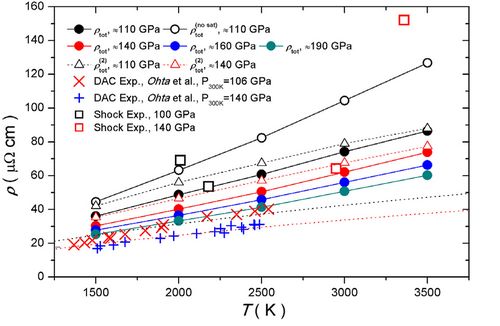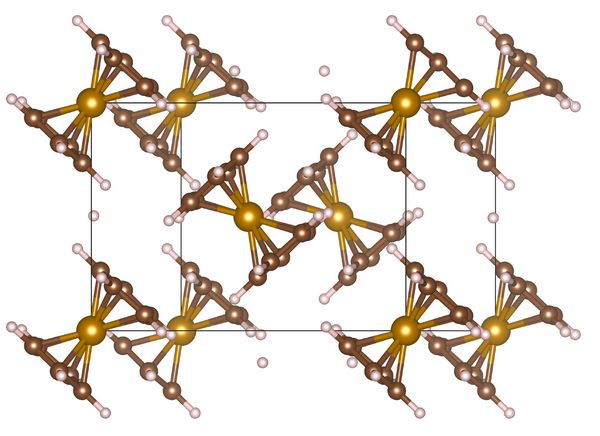ENVIRONMENT AND ENERGY
From New Materials to Planetary Cores
Principal Investigator:
Ronald Cohen
Affiliation:
Ludwig Maximilians Universität München
Local Project ID:
pr92ma
HPC Platform used:
SuperMUC and SuperMUC-NG of LRZ
Date published:
Introduction
First-principles methods use fundamental quantum physics to compute properties of materials without fitting experimental data. In this way conditions of very high pressures and temperatures can be simulated, which are very difficult or impossible to achieve in the laboratory. We can also simulate materials that do not exist yet, and thus design new materials. The underlying theory is known as Density Functional Theory (DFT), which is exact in principle, but in practice must be used with approximations. These computations often require supercomputers, because extreme precision is needed—the chemical energy is in the 8th-12th significant figure of the total energy, so numerically accurate methods are required. In many materials the straightforward application of DFT fails, because electrons are correlated in a non-mean-field way. Then we need to use special methods which are even more computationally intensive. To simulate high temperatures we use first-principles molecular dynamics (FPMD), in which we do many thousands of first-principles calculations, stepping forward in time using Newton’s law of motion F = m a, with the force F computed from quantum mechanics, m the mass of each atom, and a its acceleration. Examples of our work on SuperMUC-NG follow, for Earth’s core, filled ice on Titan, carbonated melts in Earth’s mantle, Polar metallocenes, and ferroelectric clathrates.
Iron in Earth’s Core
Earth’s magnetic field arises from turbulent motion of liquid iron alloy in Earth’s outer core. It used to be thought that thermal convection driven by Earth’s original heat provided the energy for the dynamo, but this was brought into question by first-principles computations that showed too high thermal conductivity in iron to allow for thermal convection. 1,2 However, we have shown that including electron-electron scattering it becomes possible for the traditional theory to work (Fig. 1-2). 3,4 We have continued to work on this problem, to include liquid iron and fully converge system sizes studied, and to include iron alloys.

Figure 2. Thermal conductivity for iron at core conditions. Our results in Red are higher than experiment, but lower than previous theory. From Xu et al.
New experiments on electrical resistivity of iron are in excellent agreement with our new FPMD results (Fig. 3). 5
We are often asked how our method works on other materials than iron, to show that we do not have accidental agreement. We have studied now the element Nb on SuperMUC-NG (Fig. 4) and see excellent agreement for electrical and thermal conductivity at zero pressure.

Figure 4. Electrical and thermal conductivity computed for Niobium. Note that the experiments are at constant atmospheric pressure and the theory is at constant volume, with pressures shown on the left figure. © LMU
Filled ices in water planets
Filled ices mediate the methane and oxygen contents of the atmospheres of water planets. 6 We have simulated methane filled ice, and computed its equation of state. We found that filled ice will sink in the melt, and form a shell around the core of the planet (Fig. 5).
Carbonated melts in Earth’s Mantle
Little is known about the behavior of carbon in melts, because it exsolves as pressure is released and is not found in observed magmas or volcanic rocks. Experiments are difficult because carbonated fluids are very reactive, and the usual method of studying high pressures uses the diamond anvil cell, which contains already C. We have simulated silicate melts containing carbon and have computed, for example, the diffusivities of different elements in such melts (Fig. 6,7). 7
Figure 6. Animation of first-principles molecular dynamics simulation for carbonated silicate melt. The blue atom is a carbon. With Razvan Caracas.
Polar Metallocenes
Metallocenes are interesting and useful organometallic sandwich molecules, with a transition metal ion between two cyclopentadienyl (Cp, or C5H5−) rings . Normally the molecules are symmetric, with the two rings the same, but we proposed to make asymmetric molecules, and crystallize them to form a new class of polar materials (Fig. 8,9). 8
Ferroelectric Clathrates
Recently we developed, computationally and in the laboratory, a new family of clathrates. 9 Most of this family is metallic and centrosymmetric. We considered how to make a polar, possibly ferroelectric, insulating sp3 bonded clathrate and succeeded (Fig. 10). 10
In summary, the SuperMUC-NG has been used to study a wide variety of problems in materials, ranging from planetary cores to designing new materials. This work was support by the ERC Advanced Grant ToMCaT, The US NSF grant EAR-1901813, U. S. Office of Naval Research Grants No. N00014-12-1-1038, N00014-14-1-0516, and N00014-17-1-2768, and the Carnegie Institution of Washington.
Publications
1 Pozzo, M., Davies, C., Gubbins, D. & Alfe, D. Thermal and electrical conductivity of iron at Earth's core conditions. Nature 485, 355-U399, doi:10.1038/Nature11031 (2012).
2 de Koker, N., Steinle-Neumann, G. & Vlcek, V. Electrical resistivity and thermal conductivity of liquid Fe alloys at high P and T, and heat flux in Earth's core. Proc Natl Acad Sci U S A 109, 4070-4073, doi:10.1073/pnas.1111841109 (2012).
3 Zhang, P., Cohen, R. E. & Haule, K. Effects of electron correlations on transport properties of iron at Earth's core conditions. Nature 517, 605-607, doi:10.1038/nature14090 (2015).
4 Xu, J., Zhang, P., Haule, K., Minar, J., Wimmer, S., Ebert, H. & Cohen, R. E. Thermal Conductivity and Electrical Resistivity of Solid Iron at Earth's Core Conditions from First Principles. Phys Rev Lett 121, 096601, doi:10.1103/PhysRevLett.121.096601 (2018).
5 Zhang, Y., Hou, M., Liu, G., Zhang, C., Prakapenka, V. B., Greenberg, E., Fei, Y., Cohen, R. E. & Lin, J. F. Reconciliation of Experiments and Theory on Transport Properties of Iron and the Geodynamo. Phys Rev Lett 125, 078501, doi:10.1103/PhysRevLett.125.078501 (2020).
6 Levi, A. & Cohen, R. E. The Equation of State of MH-III: A Possible Deep CH4 Reservoir in Titan, Super-Titan Exoplanets, and Moons. The Astrophysical Journal 882, doi:10.3847/1538-4357/ab2f76 (2019).
7 Solomatova, N., Caracas, R. & Cohen, R. E. in Carbon in Earth’s Interior, Geophysical Monograph Series (eds Craig E. Manning, Jung-Fu Lin, & Wendy L. Mao) 179-194 (2020).
8 Zhang, H., Yavorsky, B. Y. & Cohen, R. E. Polar Metallocenes. molecules 24, doi:10.3390/molecules24030486 (2019).
9 Zhu, L., Borstad, G. M., Liu, H., Gunka, P. A., Guerette, M., Dolyniuk, J. A., Meng, Y., Greenberg, E., Prakapenka, V. B., Chaloux, B. L., Epshteyn, A., Cohen, R. E. & Strobel, T. A. Carbon-boron clathrates as a new class of sp3-bonded framework materials. Sci Adv 6, eaay8361, doi:10.1126/sciadv.aay8361 (2020).
10 Zhu, L., Strobel, T. A. & Cohen, R. E. Prediction of an extended ferroelectric clathrate. Physical Review Letters 125, 127601, doi:10.1103/PhysRevLett.125.127601 (2020)
Scientific Contact
Professor Dr. Ronald Cohen
Ludwig Maximilians Universität München
Department für Geo- und Umweltwissenschaften
Theresienstrasse 41, D-80333 München (Germany)
e-mail: ronald.cohen [@] min.uni-muenchen.de
Local project ID: pr92ma
December 2020






